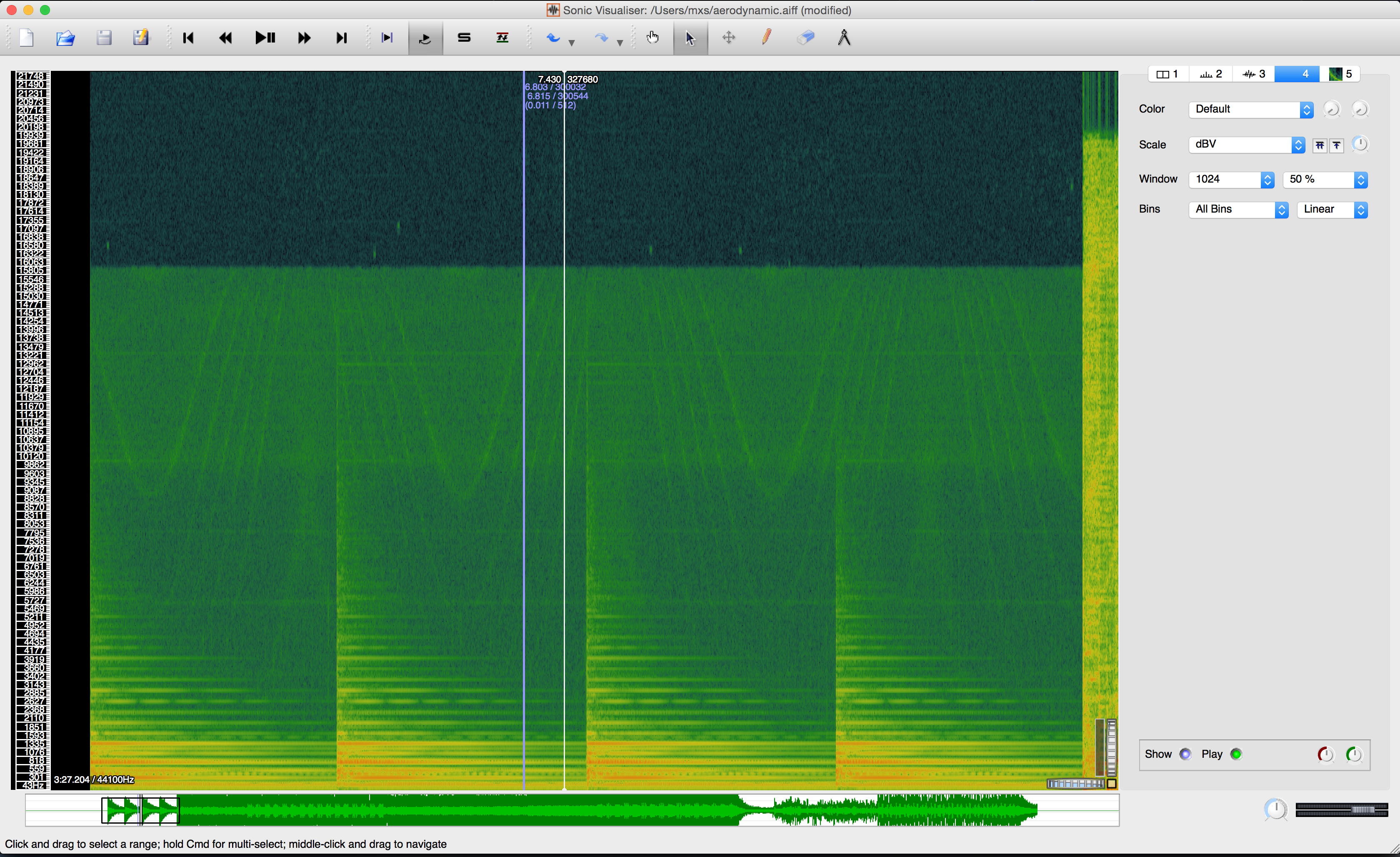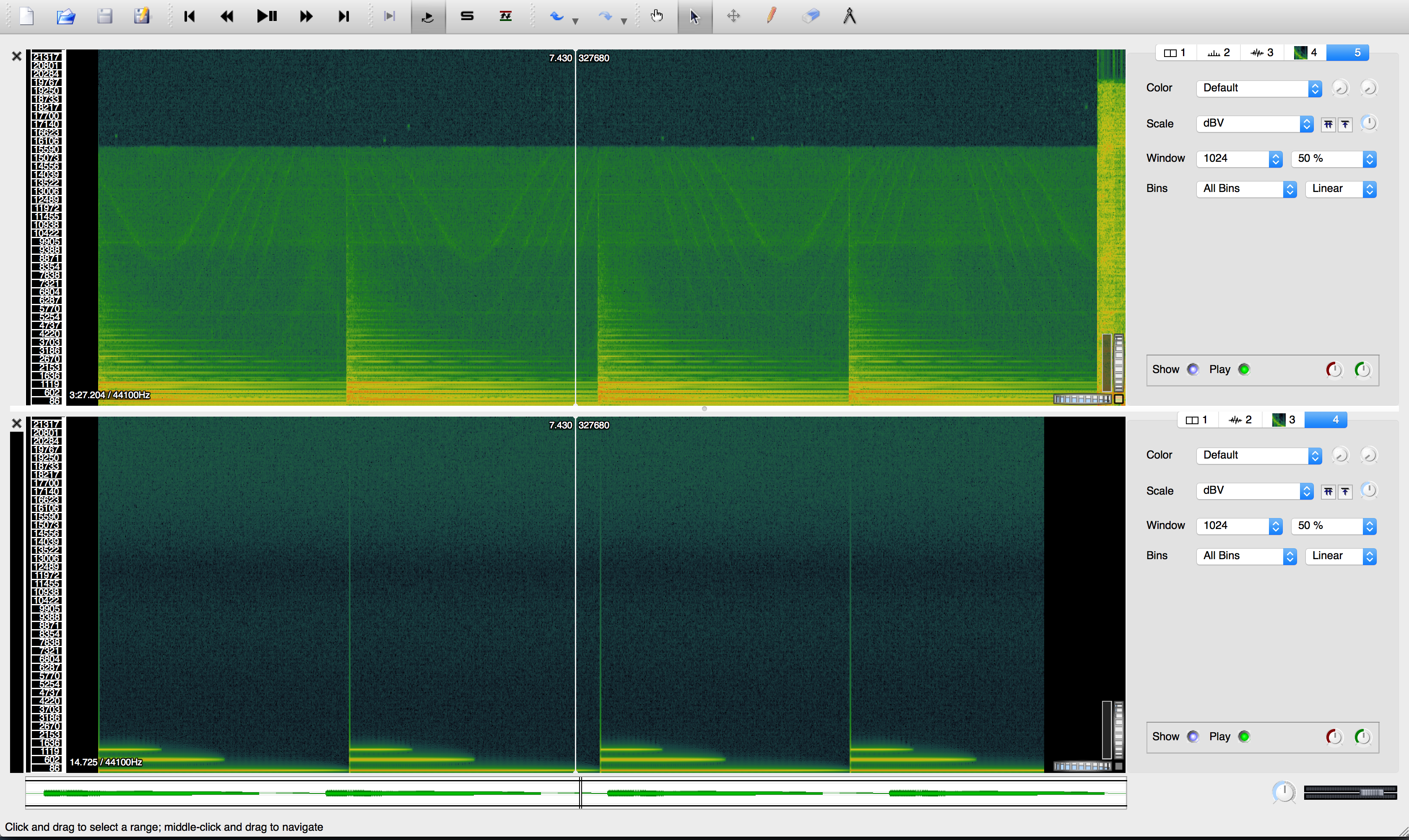Something That Rings a Bell
This article is part of the Aerodynamic guide.
We are now going to focus on the first part of the track: bell, that
is, the 4 strokes of the bell at the beginning of the track ; here is
what it looks like once imported in Sonic Visualizer:

This is a spectrogram, in abscissa we have time and in ordinate we
have audio frequencies. We can see 4 distinct areas, one for each
stroke. We also see horizontal stripes at different pitches: it
corresponds to the audio frequencies of the bell sound, the more they
tend to be red, the more intense the frequencies are. A musical
instrument generally plays a note which is represented by the most
intense frequency stripe, the other stripes are the timbre of an
instrument: each instrument has its own signature which can be more or
less elaborated (for instance, the timbre of a flute is much simpler
than a violin’s one). Here, the most intense stripe is at 220 Hz (at
the bottom of the image), that is, the note :A3.
A simple version of these 4 bell strokes can be expressed this way in Sonic Pi:
use_bpm 123
use_synth :pretty_bell
4.times do
play :A3
sleep 8
end
Which means:
- use a BPM of 123
- use the instrument
pretty_bell(one of the bells available in Sonic Pi) - do 4 times what is between
doandend(a block) - in the block, play the note
A3, then wait 8 beats
When we execute this code (the Run button), we hear a bell stroke
every 8 beats, 4 times.
First problem, the duration of the bell sound isn’t the one we are looking for (it is much shorter than in Aerodynamic). The instruments of Sonic Pi can be tweaked with parameters, some of them manipulate the duration of notes.
If we give another look at the previous spectrogram, we see that the
intensity of each frequency decreases with time: the active
frequencies are at first red (high intensity), then they progressively
become green (low intensity). Moreover, after 8 beats, they are still
slightly active, as if they were actually on 9 beats. These two
charactetistics of the note can be obtained with the release
parameter, which increases the duration of a note, and progressively
decreases its intensity :
use_synth :pretty_bell
use_synth_defaults release: 9
4.times do
play :A3
sleep 8
end
We are now closer to Aerodynamic! But that’s still not very convincing
because the timbre of the bell from Sonic Pi isn’t the same as the
one we are looking for. In other terms, the horizontal stripes
produced by Sonic Pi’s bell, despite being based on the note A3,
are different. Here’s what it looks like in Sonic Visualizer:

At the top, we have the bell from Aerodynamic ; at the bottom our
version: indeed, we are quite far from it, we are missing a lot of
timbre! We can try to fix this by playing several bells at the same
time, with reduced amplitude on octaves around A3, so as to cover a
larger part of the spectrum:
use_bpm 123
use_synth :pretty_bell
use_synth_defaults release: 9
4.times do
play :A1, amp: 0.125
play :A2, amp: 0.25
play :A3, amp: 0.75
play :A4, amp: 0.40
play :A5, amp: 0.25
sleep 8
end
When we call several times play in a row, it plays everything in
parallel, this is the call to sleep which introduces the pause,
therefore we have here 4 iterations on:
- a stroke of a bell
:A1with an amplitude of 12.5% - a stroke of a bell
:A2with an amplitude of 25% - a stroke of a bell
:A3with an amplitude of 75% - a stroke of a bell
:A4with an amplitude of 40% - a stroke of a bell
:A5with an amplitude of 25%
This fills some gaps in the spectrogram, it is still far from the original bell but it is satisfactory.
Finally, we can add some depth and distance with the help of the
gverb effect, which we apply around the play instructions:
use_bpm 123
use_synth :pretty_bell
use_synth_defaults release: 9
4.times do
with_fx :gverb, room: 20 do
play :A1, amp: 0.25
play :A2, amp: 0.5
play :A3, amp: 1.5
play :A4, amp: 0.75
play :A5, amp: 0.5
sleep 8
end
end
The gverb effect applies to the block it wraps, we use it here with
the room parameter set to 20 (its default value is 10), to increase
the distance effect.
Sonic Pi has a collection of audio effects (whose number increases
with each new release), it is possible to browse this collection via
the help at the bottom of Sonic Pi, inside the Fx pane ; each
effect has its own documentation, with the different possible
parameters:

This article is part of the Aerodynamic guide.